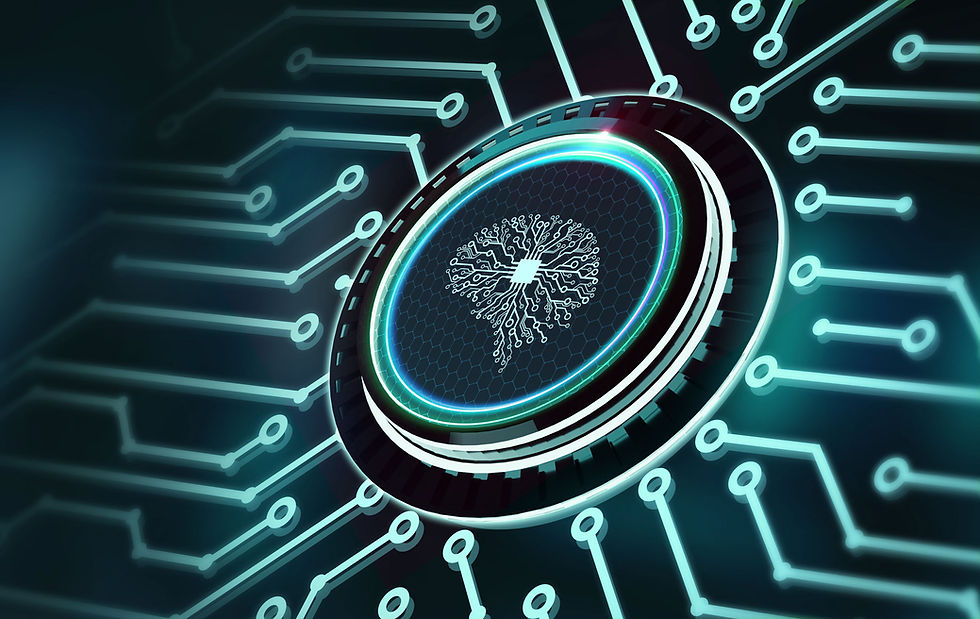Understanding NVIDIA Blackwell: The Ultimate "Distributed Brain" Architecture of the AI Era
- Amiee

- Apr 14
- 4 min read
Updated: 3 days ago
In the past, AI computations relied on a single, massive "brain" handling all tasks. Now, with NVIDIA's Blackwell architecture, AI has learned to delegate—distributing tasks across multiple specialized units, optimizing energy use, and even managing its own cooling. This isn't magic; it's the innovation of Blackwell.

NVIDIA's Blackwell GPU architecture: chiplets work together like modular brains, NVLink Switch enables ultra-fast GPU communication, and the Transformer Engine with RAS boosts AI performance and stability—bringing smart, efficient, and collaborative AI computing to life.
Introducing Blackwell Architecture
In Spring 2024, NVIDIA unveiled the Blackwell architecture, causing a stir across the tech industry. This wasn't a minor upgrade; it was a fundamental shift in AI computing, comparable to the launch of the first iPhone or the release of GPT-3.
Engineers paused their coding to study its instruction sets; AI researchers revised their training protocols; investors recalculated NVIDIA's valuation models. One commentator humorously noted, "Even our department's neglected H100 is starting to feel obsolete."
Blackwell signifies a transition from the era of "monolithic brute-force computation" to a new philosophy of "modular collaboration and integration" in AI processing.
What Is the "Distributed Brain" Architecture?
Traditional GPUs were monolithic—single, large chips containing all processing units. This design posed several challenges:
Lower Yield Rates: A defect in any part could render the entire chip unusable.
Heat and Power Issues: Concentrated components led to significant thermal and energy challenges.
Limited Scalability: Upgrading or customizing was difficult due to the all-in-one design.
Blackwell's Solution: Embrace a chiplet architecture.
Imagine replacing a solitary, overburdened chef with a well-coordinated kitchen staff, each specializing in a task—chopping, cooking, plating. Similarly, Blackwell divides the GPU into specialized modules (chiplets), each handling specific functions, and connects them through high-speed links.
This modular approach offers:
Improved Yield: Faulty modules can be replaced individually.
Enhanced Thermal Management: Dispersed components dissipate heat more effectively.
Flexible Manufacturing: Different modules can utilize optimal fabrication processes.
Scalability: Easier upgrades and customization for diverse applications.
The Dual-Die Design: Twin Brains in Harmony
Blackwell takes modularity further by integrating two chiplets into a single GPU package, connected via a 10 TB/s interconnect. This design allows the dual dies to function cohesively, effectively doubling performance without doubling power consumption.
Think of it as two synchronized dancers performing flawlessly together—each aware of the other's moves, ensuring a seamless performance.
NVLink Switch: The High-Speed Neural Network
Coordinating multiple chiplets requires rapid and efficient communication. Enter the NVLink Switch System—a high-bandwidth interconnect facilitating seamless data exchange between GPU modules.
Key features include:
1.8 TB/s Bandwidth per GPU: Doubling the capacity of previous generations.
Scalability: Supports configurations with up to 576 interconnected GPUs.
Unified Processing: Enables multiple GPUs to function as a single, cohesive unit.
This system ensures that data flows swiftly and accurately, akin to neurons transmitting signals across a brain's synapses.

The NVLink high-speed neural network, connecting multiple smiling GPUs like neurons. This fun visual represents how NVLink enables fast, synchronized communication between GPUs—allowing them to work together like a true superbrain.
Transformer Engine and RAS: Turbocharging AI with Self-Healing Capabilities
Modern AI models, like GPT, rely heavily on Transformer architectures. Blackwell enhances this with:
5th Generation Transformer Engine: Accelerates computations using lower-precision formats (FP4/FP8), balancing speed and accuracy.
Dynamic Precision Adjustment: Automatically selects the optimal precision level for tasks, optimizing performance and energy use.
Additionally, Blackwell incorporates RAS (Reliability, Availability, Serviceability) features:
Error Detection and Correction: Identifies and rectifies faults in real-time.
Continuous Operation: Maintains functionality without interruptions, even during error correction.
Imagine a high-performance car that not only accelerates rapidly but also repairs itself on the go—ensuring both speed and reliability.

Blackwell vs. Hopper: A Comparative Overview
Feature | Hopper (H100) | Blackwell (B100) |
Architecture | Monolithic | Chiplet-Based |
Performance per Watt | Baseline | 2.5× Improvement |
Training Performance | - | 4× Faster |
Inference Performance | - | 30× Faster |
NVLink Bandwidth | 900 GB/s | 1.8 TB/s |
Note: Specific performance metrics are based on NVIDIA's reported data.
Real-World Applications of Blackwell
Blackwell's advanced architecture enables a range of applications:
Training Large Language Models (LLMs): Efficiently handles models with trillions of parameters, reducing training time and energy consumption.
Real-Time Data Processing: Facilitates instant analysis and response in applications like customer service bots, medical imaging, and financial transactions.
AI Factories: Powers large-scale AI infrastructures, enabling continuous training and deployment of AI models.
Edge Computing: Supports autonomous vehicles and robotics by providing powerful, energy-efficient processing capabilities at the source.
Conclusion: Smarter, Greener, and More Collaborative AI
NVIDIA's Blackwell architecture represents a significant leap in AI computing—embracing modularity, efficiency, and resilience. It's a testament to the power of collaboration, not just among machines but as a design philosophy.
As we integrate AI deeper into our daily lives, perhaps we can take a cue from Blackwell's design: embracing teamwork, optimizing our energy, and striving for continuous improvement.
After all, if our GPUs can collaborate seamlessly and self-correct in real-time, maybe it's time we consider doing the same in our own workflows.
For more detailed information, visit NVIDIA's official Blackwell Architecture page: NVIDIA Blackwell Architecture Technical Overview





